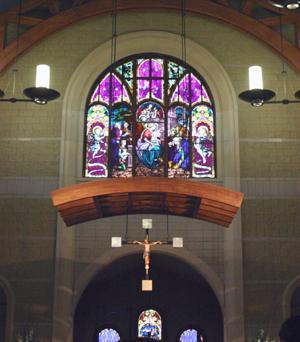
By Celine Klosterman
FAIRFIELD — St. Mary Parish wanted its new building to “look like a Catholic church,” blending traditional design with post-Vatican II directives, the parish told its architectural firm.
“A major goal of this design is to create a timeless character, one that will remain successful for generations to come,” Dave Beringer said. He is an architect with Beringer Ciaccio Dennell Mabrey of Omaha.
So the 26,600-square-foot church features a Romanesque style, with liturgical furnishings that capture the idea of “noble simplicity,” said Father Stephen Page, pastor. In a further embrace of history, the building’s brick color and detailing, wood tones, stone trim and arch-shaped windows echo those in the parish’s old home.
Seating is designed to closely gather the faithful around the altar, creating a sense of intimacy. The colonnade around the rear and sides of the worship space enhances that feeling of togetherness, Beringer said. And extending as welcoming arms are the education wing and social hall/office wing, which flank a courtyard area. Both wings are designed to accommodate potential expansion in future years.
In the courtyard, a bell tower calls parishioners to worship.
Inside the church, a stained-glass window donated by the Kilfoy family a century ago and depicting Mary, Joseph, baby Jesus, the wise men and shepherds was refurbished and installed above the altar, as in St. Mary’s former church. Bovard Studio in Fairfield added to the window side panels picturing angels holding ribbons bearing Scripture verses: “The word became flesh and dwelt among us” and “We saw his glory, full of grace and truth.”
Four other stained-glass windows — two of Jesus and two of the Virgin Mary — color the church’s walls, but traditional windows line the building’s basilica-style roof.
Above the altar hangs a Byzantine-style crucifix depicting the Christ of glory, wearing a gold crown rather than the crown of thorns, Fr. Page said.
Between the altar and Blessed Sacrament chapel, a simple, iron-curtain wall features four crosses and five Roman arches. In the chapel, the tabernacle resembles a small church, with a gold-leaf roof and four sides that, symbolically, look identical. “We remember Christ is present in all ways, in all dimensions, whatever way you face,” Fr. Page said.
The tabernacle, altar and baptismal font were placed away from walls to invite Catholics to gather around them and to promote “active, conscious participation,” he said. In the floor around the baptismal font are inscribed the verses from Romans 6:4-5, read during the Easter vigil Mass.
Fr. Page said the church’s ceiling, painted dark blue at his request, reflects the color of St. Mary’s patron saint.
In the sanctuary, a matching altar and ambo made of dark surrey granite and a lighter Dunbar granite complement the presider’s chair and deacon’s chair, both made of Dunbar granite and cherry wood.
Iron consecration candlesticks used during the church’s dedication Mass hold oil candles — the church’s “birthday candles,” Fr. Page said. The 12 candles — the number of which reflects the Twelve Apostles – also will be used for Masses during holidays such as Easter and Christmas, he said.
Hung on the church’s walls are bronze Stations of the Cross attached to granite slabs. Two five-foot-tall triptychs, which will hold artwork, await a painter’s donation. “My hope is to have them picture saints from the Americas, like Elizabeth Ann Seton,” Fr. Page said.
In its entirety, St. Mary’s new church “reflects the values of people in southeast Iowa,” Fr. Page said. “We’re hardworking, focused people, not pretentious … our way of life is plain, not filled with airs and fanciness.”
The building also represents a new era for the parish, he said. “Our first church in 1864 was wood. Our next church in 1907 was brick. Now, we’re beginning with steel and concrete. There’s always growth and change. It’s nice to see that progress.”








